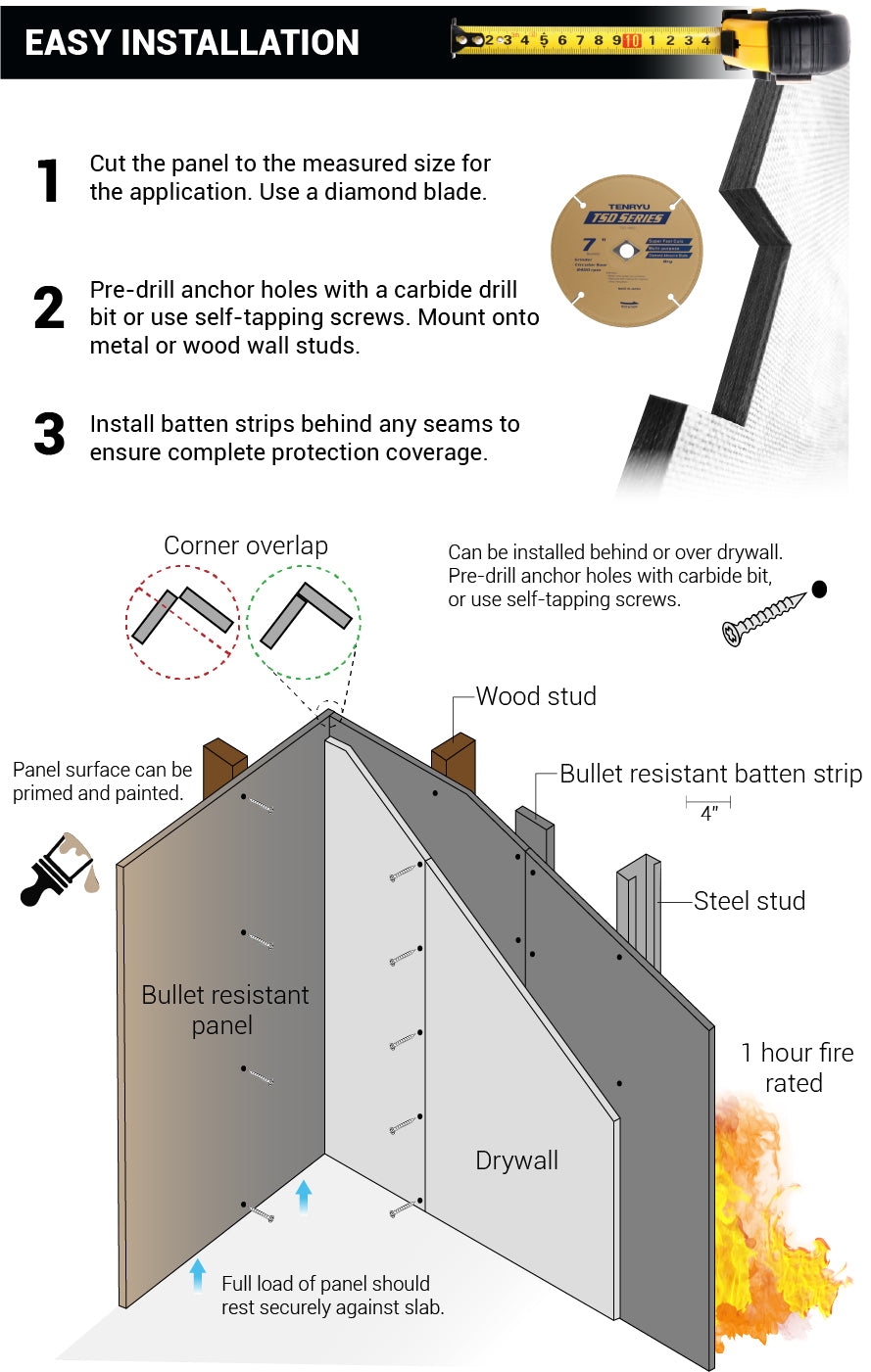
Level 7 Bullet and Fire Resistant Fiberglass Wall Panel UL 752 Rated
Usually Ships In:
Shipping & Delivery
This product ships via LTL freight due to its size and weight. Please ensure that your delivery location is equipped with either a forklift or a loading dock to safely offload the shipment. If your site is not equipped for LTL delivery, additional delivery arrangements may be required and could result in extra charges.
Learn More
Overview
Our bullet-resistant panels are specifically designed to absorb the energy of a bullet within the panel's laminate. The composite laminate is made up of woven fiberglass that is reinforced with resin, making it capable of defeating a bullet by absorbing its energy. As the panel delaminates from impact, any additional shots become easier to defeat because the laminate is better able to absorb the energy of the bullet. Unlike steel barriers, our fiberglass laminate is designed to prevent ricochets and spalling on the non-threat side of the panel.
Our bullet-resistant fiberglass panels are commonly used in a variety of architectural facility designs, including commercial, schools, financial institutions, government facilities, grid security, healthcare facilities, law enforcement, military, residential buildings, safe rooms, and more. These panels can be incorporated into wall assemblies, counters, doors, millwork, cubicles, and desks to provide superior protection against potential threats.
The benefits of using bullet-resistant fiberglass panels in architectural designs include:
Enhanced safety: The primary benefit of using bullet-resistant fiberglass panels is the increased safety they provide to the occupants of the building. These panels can prevent injuries and even fatalities by stopping bullets from penetrating and causing harm.
Versatility: Bullet-resistant fiberglass panels can be used in a variety of architectural designs, including walls, counters, doors, and desks. This versatility allows architects and designers to incorporate them seamlessly into any building design.
Durability: Fiberglass reinforced with resin is a highly durable material that can withstand repeated impact from bullets. This durability makes bullet-resistant fiberglass panels a cost-effective solution for long-term security needs.
Reduced ricochet and spalling: Unlike steel barriers, fiberglass laminate is designed to prevent ricochet and spalling on the non-threat side of the panel, further enhancing the safety of occupants.
Aesthetically pleasing: Bullet-resistant fiberglass panels are available in a variety of colors and finishes, making them a more aesthetically pleasing option than steel barriers.
Overall, the use of bullet-resistant fiberglass panels in architectural designs can enhance the safety and security of buildings and their occupants while also offering versatility, durability, and aesthetic appeal.
UL 752 Industry Standards
Underwriters Laboratories, Inc., the world’s oldest and largest, not for profit, independent testing company, wrote the standard for bullet resistant materials. The UL752 standard has been widely accepted throughout the world as the standard for architectural bullet resistive building materials.
Our panels have been tested according to that standard by Underwriters Laboratories, Inc. A ballistic resistive product becomes “UL Listed” after being subjected to a variety of ballistic tests which include shooting the materials while frozen at -25 degrees Fahrenheit and while heated to 120 degrees Fahrenheit. After the initial testing series, the product is then set up for maintenance testing that involves “pulling random samples” without notice from the manufacturer’s routine production on a quarterly rotation. This rigorous testing schedule ensures that the product is being made without variation and has the highest level of ballistic resistive integrity available.
Curved Desk or Wall
Bending panels around a curved desk or wall is possible using Level 1 panels only. A level 3 rating can be achieved by cutting the panels to size and segmenting them or by overlapping the panels to cover the seams. Using stacked Level 1 panels at 1/4” thick will equal the 1/2” Level 3 desired protection.
Level 1 - 6" Radius Maximum
Level 2 - 12" Radius Maximum
Level 6 - 14" Radius Maximum
Level 3 - 20" Radius Maximum

















